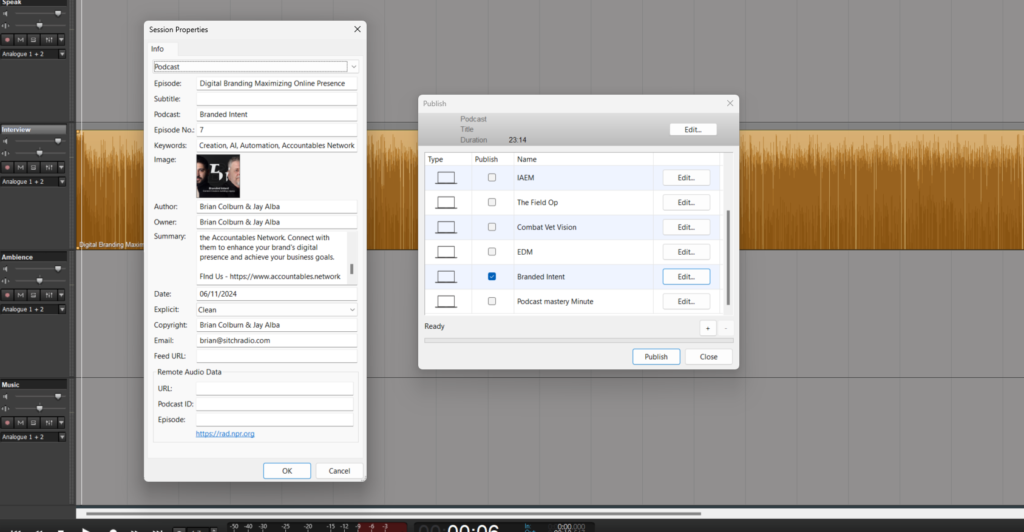Managing Your Podcast Pre-Production Process Effectively

From my experience producing shows, meticulous pre-production planning is the cornerstone of a successful podcast. Our refined pre-production processes, which involve detailed outlines, thorough research, and engaging content scripting, have empowered us to create well-structured, captivating episodes that deeply resonate with our audience. This level of preparation not only sets the stage for smooth recording sessions but instills a sense of accomplishment and confidence in our storytelling.
Our rigorous pre-production preparation is not just about enhancing the quality of our show but also about valuing our audience. It’s about ensuring that our podcast connects with listeners meaningfully, fostering a loyal and engaged community. Effective pre-production is the key to transforming a good show into a great one that leaves a lasting impact on our audience.
Creating a successful podcast is a collaborative effort, and your role as the audience is crucial. It involves much more than just hitting the record button. This guide is designed to walk you through the essential steps of planning your content and crafting a seamless script and flow for your podcast because we value your time and engagement.
Planning Your Content
Episode Outline
A detailed episode outline ensures your podcast flows smoothly and covers all necessary points. Here’s how you can elaborate on this step:
- Segment Breakdown: Divide the episode into clear segments. For example:
- Introduction (2 minutes): Welcome listeners, introduce the topic, and provide an overview of what will be covered.
- Main Content (10 minutes): Dive into the main discussion, breaking it down into smaller parts if necessary.
- Sub-segment 1 (5 minutes): Discuss the first significant point or story.
- Sub-segment 2 (5 minutes): Discuss the second central point or story.
- Interview Segment (10 minutes): If you have a guest, prepare questions and allow time for their answers and follow-up questions.
- Conclusion (3 minutes): Recap the main points, provide a call to action, and thank listeners and guests.
Example: If your episode is about “The Benefits of Remote Work,” the outline might look like this:
- Introduction: Welcome, episode topic overview, and why it’s relevant today.
- Main Content:
- Benefits for Employees: Flexibility, work-life balance, reduced commute stress.
- Benefits for Employers: Cost savings, access to a broader talent pool, increased productivity.
- Interview Segment: Conversation with a remote work expert about best practices and challenges.
- Conclusion: Summary of benefits, reminder of critical points, encouragement to try remote work, call to action to visit the Website for more resources.
Content Research
Research is the backbone of a well-informed podcast episode. Here’s how to approach it:
- Identify Sources: Find reliable sources such as academic articles, industry reports, and expert opinions.
- Gather Data: Collect relevant facts, statistics, and quotes that support your episode’s topic.
- Conduct Interviews: Interview experts or individuals with firsthand experience related to the topic.
- Review Previous Episodes: If the topic has been discussed before, review past episodes to ensure new content and perspectives are provided.
Example: For an episode on “The Future of Electric Vehicles,” research might include:
- Articles and Reports: Recent publications on advancements in electric vehicle technology, market trends, and environmental impacts.
- Expert Interviews: Conversations with industry experts, automotive engineers, and environmentalists.
- Statistics: Data on electric vehicle adoption rates, government incentives, and consumer preferences.
Script Writing
Whether you prefer a full script or bullet points, having a written guide helps maintain focus and clarity.
- Full Script: Write out every word you plan to say. This is useful for ensuring precise communication, especially for complex topics or when you must stay on message.
- Bullet Points: Outline critical points and subpoints. This allows for a more natural and conversational tone while ensuring you cover all necessary information.
Example: For a full script on “How to Start a Podcast”:
- Introduction: “Welcome to [Podcast Name], the show where we help aspiring podcasters create their dream shows. I’m your host, [Name], and today we’re discussing how to start your podcast from scratch…”
- Bullet Points for the same topic might include:
- Welcome and episode overview
- Choosing a podcast topic
- Essential equipment
- Recording and editing tips
- Publishing and promoting your podcast
Segment Planning
Decide on the different segments to keep the episode engaging and structured.
- Interviews: Plan questions and topics to discuss with your guest.
- Discussions: Outline key points for group discussions, ensuring each participant knows their role.
- News Segments: Summarize the latest news relevant to your topic and provide commentary.
Example: For an episode on “Mental Health Awareness”:
- Introduction: Overview of the episode and its importance.
- Personal Story: Share a personal anecdote or listener’s story about mental health.
- Expert Interview: Discussion with a mental health professional about coping strategies.
- Resource Highlight: Information about where listeners can find support and resources.
Script and Flow
Writing the Intro and Outro
Crafting compelling intros and outros sets the tone for your podcast and leaves a lasting impression.
- Introduction: Engage listeners from the start, introduce the topic and yourself, and provide an episode overview.
- Example: “Hello, and welcome to [Podcast Name]. I’m your host, [Name], and today, we’re exploring the world of remote work. We’ll explore its benefits for both employees and employers and talk to a person who has successfully managed a remote team for over a decade.”
- Outro: Summarize key points, thank guests and listeners, and provide a call to action.
- Example: “Thank you for joining us on this episode of [Podcast Name]. We hope you found our discussion on remote work insightful. Don’t forget to visit our website at [Website] for more resources and subscribe to our podcast for great content. Until next time, stay productive!”
Transitions
Smooth transitions keep the episode flowing and help maintain listener engagement.
- Verbal Cues: Use phrases like “Next, we’ll discuss…” or “Let’s move on to…”
- Sound Effects/Music: Brief sound clips or music can signal a shift to a new segment.
Example: “Now that we’ve covered employee benefits, let’s discuss how remote work benefits employers. But first, here’s a quick break for a message from our sponsor.”
Engagement Hooks
Hooks are essential for grabbing and maintaining your audience’s attention.
- Teasers: Tell listeners to stay tuned by hinting at what’s coming up.
- Questions: Pose intriguing questions that you’ll answer later in the episode.
- Cliffhangers: End a segment with a cliffhanger to encourage listeners to stay engaged.
Example: “Coming up, we’ll hear from a remote work expert about the biggest challenges companies face and how to overcome them. But first, did you know that nearly 70% of employees say they’re more productive when working remotely? Stay tuned to find out why.”
Recommendations for Time Management
Now that we have established a robust pre-production process, it’s time to focus on how effective time management can further enhance productivity. By streamlining our workflow, setting clear deadlines, and utilizing tools to automate and organize tasks, we can maximize our efficiency and ensure that each production phase runs smoothly. Delegating responsibilities, batching similar tasks, and maintaining a well-structured schedule will help us stay on track and reduce the stress of last-minute preparations. Embracing these time management strategies allows us to dedicate more energy to creativity and storytelling, ultimately producing high-quality content that captivates our audience and keeps them returning for more.
Streamline Your Workflow
- Batch Tasks: Group similar tasks together. For example, dedicate a specific time to all research, another to script writing, and another to recording.
- Use Templates: Create templates for your episode outlines, scripts, and social media posts to save time and ensure consistency.
- Automate: Utilize tools to automate repetitive tasks such as scheduling social media posts or sending guest invitations.
Delegate Responsibilities
- Team Collaboration: If you have a team, assign specific roles such as research, script writing, editing, and promotion to different members.
- Outsource: Consider outsourcing tasks that are time-consuming or outside your expertise, such as audio editing or graphic design.
Set Deadlines
- Create a Production Schedule: Plan your production timeline, setting clear deadlines for each phase, from research to final editing.
- Use Project Management Tools: Tools like Trello, Asana, or Monday.com can help keep track of tasks and deadlines, ensuring everything stays on schedule.
Stay Organized
- File Management: Label your research, scripts, audio files, and promotional materials appropriately and organize them in labeled folders.
- Regular Reviews: Periodically review your workflow and adjust as needed to improve efficiency.
Motivational Closing
Producing a podcast is a creative and fulfilling endeavor, but it requires careful planning and time management to deliver high-quality content consistently. By implementing the strategies outlined in this article, you can streamline your pre-production process and create engaging episodes more efficiently. Remember, consistency is critical to building a loyal audience; managing your time effectively will help you maintain that consistency. Draw from these recommendations to refine your workflow, stay organized, and maximize your creative efforts.
Embrace the journey, and let your passion for storytelling shine through every episode.




